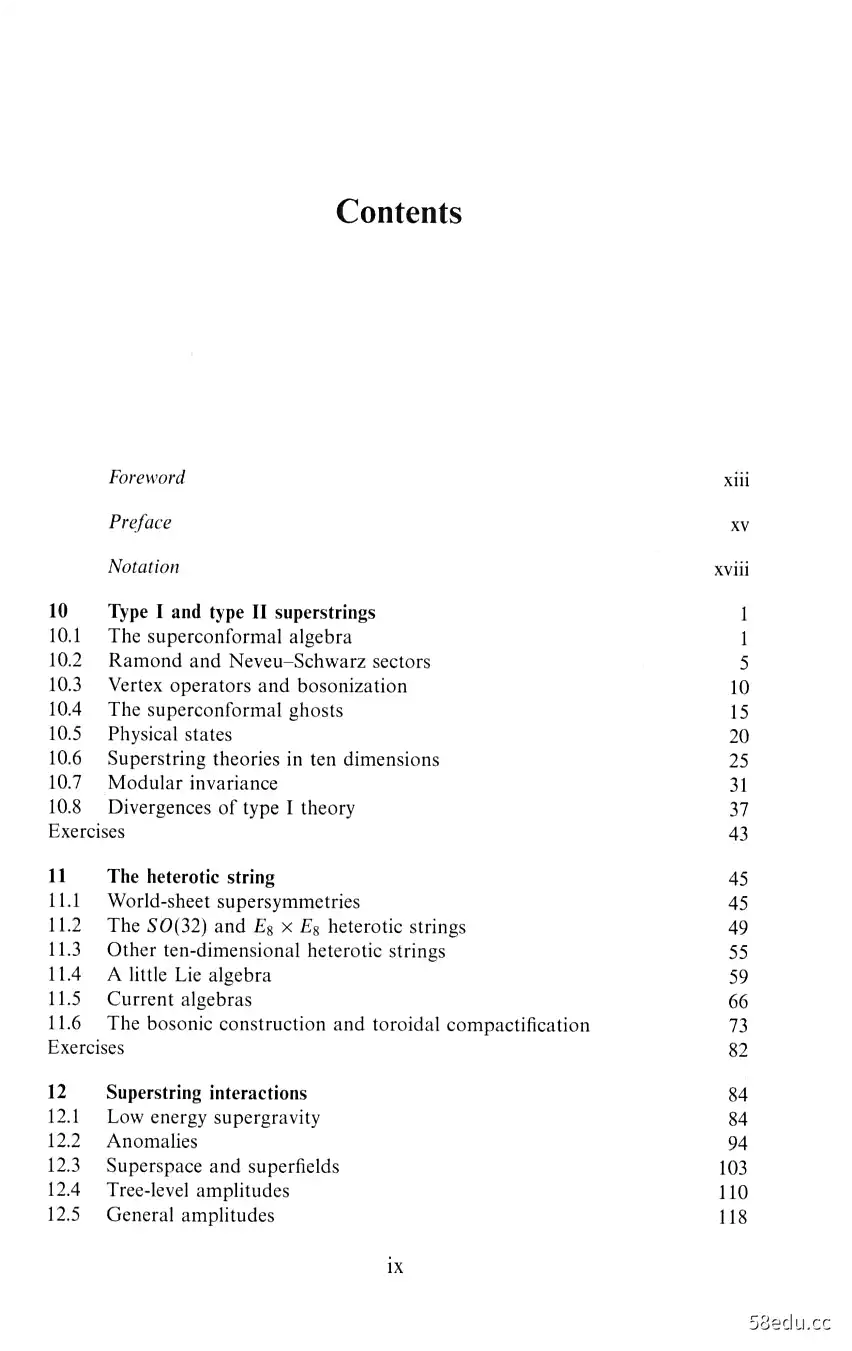《弦论 第2卷》(美)J.波钦斯基|(epub+azw3+mobi+pdf)电子书下载
图书名称:《弦论 第2卷》
- 【作 者】(美)J.波钦斯基
- 【页 数】 531
- 【出版社】 北京/西安:世界图书出版公司 , 2019.03
- 【ISBN号】978-7-5192-5398-1
- 【价 格】145.00
- 【分 类】理论物理学-英文
- 【参考文献】 (美)J.波钦斯基. 弦论 第2卷. 北京/西安:世界图书出版公司, 2019.03.
图书封面:
图书目录:


《弦论 第2卷》内容提要:
这套两卷本的《弦论》系统介绍了弦理论的各个方面。诺贝尔奖获得者StevenWeinberg教授称本书作者J.波钦斯基是弦理论最佳“入门”引导者,他发现的D-膜是研究各种不同弦理论之间的对偶关系的重要组成部分。此外,作者还有从繁杂的数学公式中发现其物理重要性并能清楚地向读者阐述的超人智慧。本套书是弦理论和数学物理中的诸多专家都公认的难得的佳作,值得每一位想学习和掌握弦理论的研究生和科研人员拥有。 本书是其中的第2卷,为英文版。共分10章,内容包括I型和II型超级环、杂色线、超弦相互作用、D膜等。
《弦论 第2卷》内容试读
10
Type I and type II superstrings
Having spent volume one on a thorough development of the bosonicstring,we now come to our real interest,the supersymmetric string the-ories.This requires a generalization of the earlier framework,enlargingthe world-sheet constraint algebra.This idea arises naturally if we try toinclude spacetime fermions in the spectrum,and by guesswork we are ledto superconformal symmetry.In this chapter we discuss the (1,1)supercon-formal algebra and the associated type I and II superstrings.Much ofthe structure is directly parallel to that of the bosonic string so we canproceed rather quickly,focusing on the new features.
10.1 The superconformal algebra
In bosonic string theory,the mass-shell condition
Pup#+m2 =0
(10.1.1)
came from the physical state condition
Lolp〉=0,
(10.1.2)
and also from Loly)=0 in the closed string.The mass-shell conditionis the Klein-Gordon equation in momentum space.To get spacetimefermions,it seems that we need the Dirac equation
ipuT“+m=0
(10.1.3)
instead.This is one way to motivate the following generalization,and itwill lead us to all the known consistent string theories.
Let us try to follow the pattern of the bosonic string,where Lo and Loare the center-of-mass modes of the world-sheet energy-momentum tensor(TB,TB).A subscript B for 'bosonic'has been added to distinguish thesefrom the fermionic currents now to be introduced.It seems then that we
1
2
10 Type I and type II superstrings
need new conserved quantities Tr and TF,whose center-of-mass modesgive the Dirac equation,and which play the same role as TB and TB inthe bosonic theory.Noting further that the spacetime momenta p are thecenter-of-mass modes of the world-sheet current (Ox",x"),it is naturalto guess that the gamma matrices,with algebra
{T4,}=2nw,
(10.1.4)
are the center-of-mass modes of an anticommuting world-sheet field y".
With this in mind,we consider the world-sheet action
1
S-4π
exXp"on+
(10.1.5)
For reference we recall from chapter 2 the XX operator product expansion
(OPE)
X“(2,2)X”(0,0)-2nm1nz2.
(10.1.6)
The y conformal field theory (CFT)was described in section 2.5.Thefields 4 and p4 are respectively holomorphic and antiholomorphic,andthe operator products are
p“(2p'(0)~ng“(2)0"(0)
(10.1.7)
The world-sheet supercurrents
TF(z)=i(2/)1/2p“(z)0X(z),Tr(a)=i(2/)1/2p“(z)aX.()(10.1.8)are also respectively holomorphic and antiholomorphic,since they are justthe products of(anti)holomorphic fields.The annoying factors of(2/a)1/2could be eliminated by working in units where a'=2,and then be restoredif needed by dimensional analysis.Also,throughout this volume thenormal ordering of coincident operators will be implicit.
This gives the desired result:the modes o and o will satisfy thegamma matrix algebra,and the centers-of-mass of Tr and Tr will havethe form of Dirac operators.We will see that the resulting string theoryhas spacetime fermions as well as bosons,and that the tachyon is gone.
From the OPE and the Ward identity it follows (exercise 10.1)that thecurrents
"(z)=n(z)Tr(z),”()=n(z)*Tr(2)
(10.1.9)
generate the superconformal transformation
e-1(2/a)1/2δX(z,2)=+n(z)p“(z)+n(z)*Φ“(2),(10.1.10a)e-1(x/2)1/2δp(z)=-n(z)0X(z),
(10.1.10b
e-1(a/2)1/2δ0“(z)=-n(z)*aX“(z).
(10.1.10c)
10.1 The superconformal algebra
3
This transformation mixes the commuting field X#with the anticommut-ing fields v4 and "so the parameter n(z)must be anticommuting.Aswith conformal symmetry,the parameters are arbitrary holomorphic orantiholomorphic functions.That this is a symmetry of the action (10.1.5)follows at once because the current is (anti)holomorphic,and so con-served.
The commutator of two superconformal transformations is a conformaltransformation,
δm1δ2-δn2δm1=δ,v(z)=-211(z)12(z),
(10.1.11)
as the reader can check by acting on the various fields.Similarly,thecommutator of a conformal and superconformal transformation is a su-perconformal transformation.The conformal and superconformal trans-formations thus close to form the superconformal algebra.In terms of thecurrents,this means that the OPEs of Tr with itself and with
T8=-10X"0X-30Pm
(10.1.12)
close.That is,only TB and Tr appear in the singular terms:
TseT0~识+2ra0+aTo,
(10.1.13a)
TB(z)TF(0)2Tr0)+0Tr0),
3
(10.1.13b)
D 2
Tr(2)Tr0)~23+2TBo),
(10.1.13c)
and similarly for the antiholomorphic currents.The TBTF OPE impliesthat Tr is a tensor of weight (0).Each scalar contributes 1 to the centralcharge and each fermion for a total
c=(1+)D=D
(10.1.14)
This enlarged algebra with Tr and TF as well as TB and TB will playthe same role that the conformal algebra did in the bosonic string.Thatis,we will impose it on the states as a constraint algebra-it mustannihilate physical states,either in the sense of old covariant quantization(OCQ)or of Becchi-Rouet-Stora-Tyutin (BRST)quantization.Becauseof the Minkowski signature of spacetime the timelike o and o,like
Xo,have opposite sign commutators and lead to negative norm states.
The fermionic constraints Tr and Tr will remove these states from thespectrum.
More generally,the N =1 superconformal algebra in operator product
4
10 Type I and type II superstrings
form is
2z4+22TB(0)+2aTs(0),.2
TB(z)TB(O)
(10.1.15a)
22Tr(0)+2aTr(0),3
1
TB(z)TF(O)~
(10.1.15b)
2c2
Tr(e)Tr0)~3+2Ta(0).
(10.1.15c)
The Jacobi identity requires the same constant c in the TB TB and TFTFproducts (exercise 10.5).Here,N =1 refers to the number of (,0)currents.In the present case there is also an antiholomorphic copy of thesame algebra,so we have an (N,N)=(1,1)superconformal field theory(SCFT).We will consider more general algebras in section 11.1.
Free SCFTs
The various free CFTs described in chapter 2 have superconformal gen-eralizations.One free SCFT combines an anticommuting bc theory witha commuting By system,with weights
hb=2,he=1-2,
(10.1.16a)
hg=元-3,h,=2-.
(10.1.16b)
The action is
Sc=2元/d2z (bic+Bay),
(10.1.17)
and
TB-(ab)e-20bc)+(aBy-2(22-1)a(B)
(10.1.18a)
Tr=-号c+24aBa-2
(10.1.18b)
The central charge is
[-3(22-1)2+1]+[3(22-2)2-1]=9-122
(10.1.19)
Of course there is a corresponding antiholomorphic theory.
We can anticipate that the superconformal ghosts will be of this formwith =2,the anticommuting (2,0)ghost b being associated with thecommuting(2,0)constraint TB as in the bosonic theory,and the commut-ing (3,0)ghost B being associated with the anticommuting(,0)constraintTF.The ghost central charge is then -26+11 =-15,and the conditionthat the total central charge vanish gives the critical dimension
3
0=D-15→D=10
(10.1.20)
10.2 Ramond and Neveu-Schwarz sectors
5
For入=2,
3
Ta=-(0b)e-2b0c-(087-Boy,
(10.1.21a)
TF (0B)c+Boc-2by.
(10.1.21b)
Another free SCFT is the superconformal version of the linear dilatontheory.This has again the action (10.1.5),while
Taa)=-ax"aX.+na2X4-pape,
(10.1.22a)
Tr(z)=i(2/)1/2p“aX4-i(2x)1/2Vuap“,
(10.1.22b)
each having an extra term as in the bosonic case.The reader can verifythat these satisfy the N=1 algebra with
3
c=D+6dvuVn.
(10.1.23)
10.2 Ramond and Neveu-Schwarz sectors
We now study the spectrum of the X4y"SCFT on a circle.Much of thisis as in chapter 2,but the new ingredient is a more general periodicitycondition.It is clearest to start with the cylindrical coordinate w=a1+io2.
The matter fermion action
∫w(eae9+8.
(10.2.1)
must be invariant under the periodic identification of the cylinder,ww+2r.This condition plus Lorentz invariance still allows two possibleperiodicity conditions for y",
Ramond(R):p“(w+2π)=+p“(w),
(10.2.2a)
Neveu-Schwarz(NS):p“(w+2π)=-p“(w),
(10.2.2b)
where the sign must be the same for all u.Similarly there are two possibleperiodicities for "Summarizing,we will write
p“(w+2π)=exp(2πiv)p“(w),
(10.2.3a)
p“(m+2π)=exp(-2πi)p“(w),
(10.2.3b)
where v and take the values 0 and
Since we are initially interested in theories with the maximum Poincareinvariance,X4 must be periodic.(Antiperiodicity of Xu is interesting,andwe have already encountered it for the twisted strings on an orbifold,butit would break some of the translation invariance.)The supercurrent then
6
10 Type I and type II superstrings
has the same periodicity as the corresponding y,
Tr(w+2π)=exp(2πiv)Tr(w),
(10.2.4a)
Tr(w+2π)=exp(-2πi)Tr(w).
(10.2.4b)
Thus there are four different ways to put the theory on a circle,each ofwhich will lead to a different Hilbert space-essentially there are fourdifferent kinds of closed superstring.We will denote these by (v,orby NS-NS,NS-R,R-NS,and R-R.They are analogous to the twistedand untwisted sectors of the Z2 orbifold.Later in the chapter we willsee that consistency requires that the full string spectrum contain certaincombinations of states from each sector.
To study the spectrum in a given sector expand in Fourier modes,
(w)=1/2∑p'exp(irw),p“(o)=i/2∑exp(-irm),
r∈Z+v
r∈Z+V
(10.2.5)
the phase factors being inserted to conform to convention later.On eachside the sum runs over integers in the R sector and over (integers +in the NS sector.Let us also write these as Laurent expansions.Besidesreplacing exp(-iw)-z we must transform the fields,
p5n(2)=(0zw)1/2p6nw)=i1/2z-1/2p%nw).
(10.2.6)
The clumsy subscripts are a reminder that these transform with half theweight of a vector.Henceforth the frame will be indicated implicitly bythe argument of the field.The Laurent expansions are then
p(z)=∑4
站
zr+1/2,0“(2)=
2r+1/2·
(10.2.7)
r∈Z+v
r∈Z+v
Notice that in the NS sector,the branch cut in z-1/2 offsets the originalantiperiodicity,while in the R sector it introduces a branch cut.Let usalso recall the corresponding bosonic expansions
20
X(z)=-2
ax(2)=-i2
三m+1,
(10.2.8)
where ao=o=(a'/2)1/2p"in the closed string and ao=(2a')1/2p"in theopen string.
The OPE and the Laurent expansions (or canonical quantization)givethe anticommutators
{p4,pg}={p,p}=nwδ,-s,
(10.2.9a)
[%,0]=[%,]=mnwδm,-n
(10.2.9b)
···试读结束···


